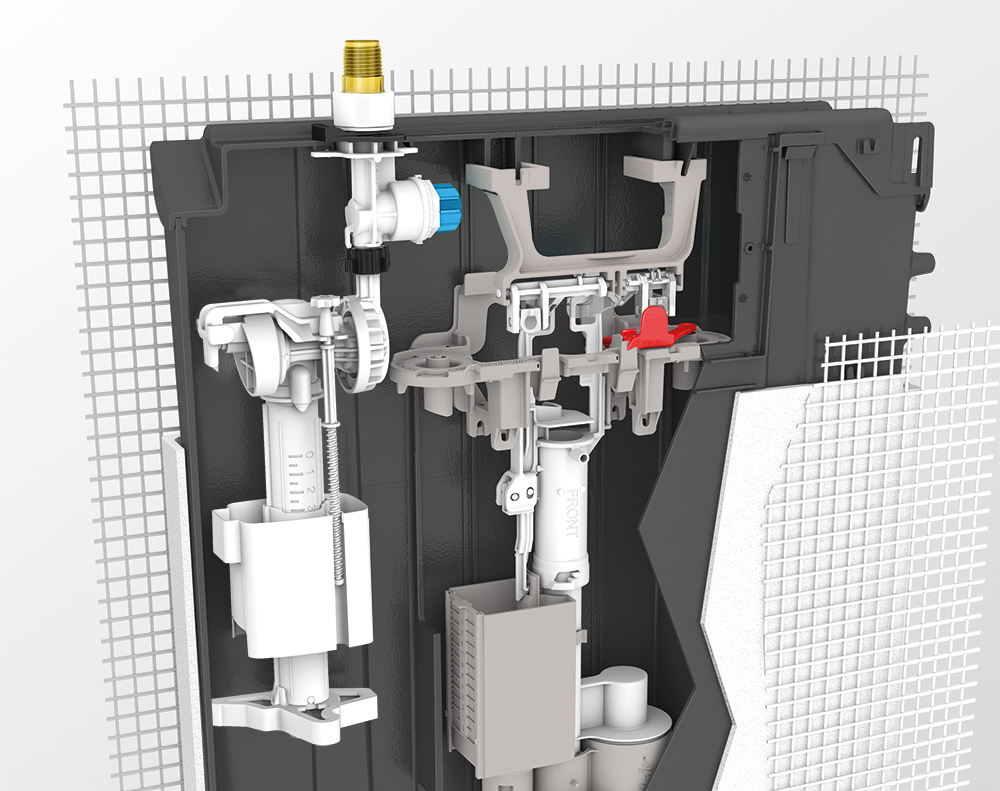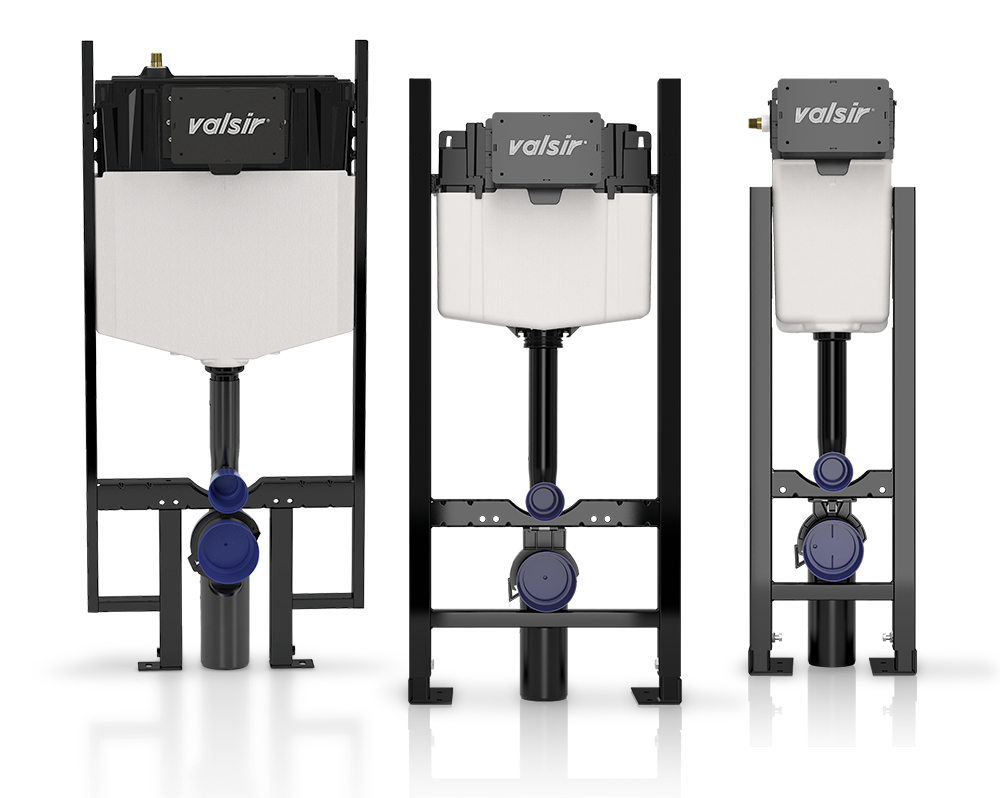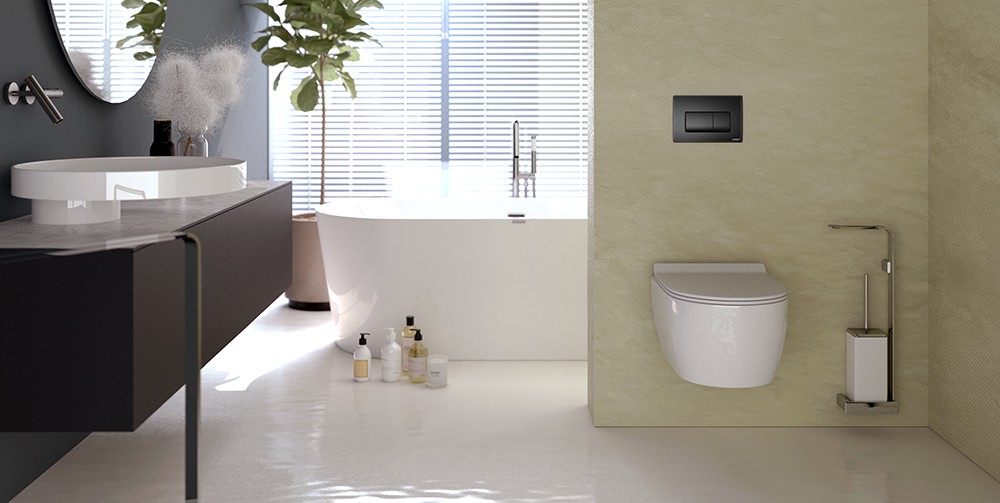The toilet cistern, often hidden from view in the case of in-wall versions, is a fundamental element of the plumbing system. Its main function is to contain and then release, through a waste mechanism, the water necessary for cleaning the toilet bowl.
Cisterns are divided into two main categories: in-wall and exposed. The former are preferred in modern residential contexts for aesthetic and space reasons, while the latter are still used in public contexts or renovations where invasive work is to be avoided.
The technological evolution of toilet cisterns
In recent decades, cisterns have undergone a major transformation. From ceramic containers capable of discharging more than 10 litres per flush, we have moved on to plastic systems that guarantee quietness, durability and water savings.
Today, the standard is 6/3 litres (full/partial flush), with options adjustable to 4.5/3 or 4/2 litres to further optimise drinking water consumption. The design has also focused on sound insulation: sound-absorbing materials reduce the noise generated by filling, making the user experience more comfortable.
How a modern toilet cistern works
Inside a toilet cistern there are three main components: the stop valve, which connects the cistern to the water supply and allows the water flow to be stopped (e.g. for maintenance); the float valve, which controls the water level and stops the water flow once the preset volume has been reached; the flush valve, which is activated by pressing the button and flushes the toilet.

Modern systems are designed to simplify adjustments and reduce maintenance times. They also comply with European standards such as ISO EN 3822 for quiet operation and the British WRAS certification for hygiene safety, preventing the risk of water returning to the drinking water supply.
In-wall toilet cisterns: advantages of Valsir models
The in-wall cistern is now the preferred solution for modern bathrooms. We have designed three models that now meet all possible installation requirements:
- Tropea S, the 90 mm thick cistern, made from an exclusive plastic compound with high sound absorption. Also suitable for thin walls such as those typically found in residential buildings in Italy, it is CE EN 14055 certified.
- Winner S, the lowest on the market (allowing a minimum installation height of 800 mm), with great installation versatility and a plate that can be positioned at the front or from above. It is also ISO EN 3822 certified and CE marked.
- Cubik S, the most compact, ideal for small spaces and particularly suitable for installations where the cistern needs to be offset from the toilet bowl. It is CE EN 14055 marked.

Exposed cistern: when to choose it
Although less common in modern bathrooms, exposed cisterns are still used in public buildings and in some renovations. Their main advantage is that they allow easy access to the internal components for maintenance.
They are often made of UV-treated materials to better withstand direct light and heat. They can be installed at standard or large heights, combined with squat toilets or preferred when masonry work is to be avoided.
Internal or external? Today, ‘old’ chain cisterns are almost exclusively found in public places, where they are installed for ease of maintenance or to achieve a vintage look. The versatility, functionality and discretion of in-wall cisterns are now the standard for residential installations.
The role of the float valve in the cistern/h2>
The float valve is a fundamental device that regulates the flow of water into the cistern according to a preset quantity. It consists of a head and a float chamber that determines its operating height (and therefore also determines at what point the cistern stops filling).
Modern Valsir floats are tested up to 30 bar, are resistant to water hammer and designed to prevent contamination of the water circuit in the event of pressure drops. They are made of different plastic materials to improve limescale resistance and self-cleaning capacity.
Flush valve: the heart of the flushing system
The flush valve is responsible for cleaning the toilet bowl. It must ensure a powerful, efficient flush that is also compatible with rimless toilets.
Valsir toilet cisterns are equipped with patented valves with silicone seals. They can be set to regulate the amount of water flushed, meeting water saving requirements without sacrificing performance.
Energy efficiency and environmental sustainability
Today, sustainability is finally a value that can influence market choices. Our toilet cisterns are made from recyclable materials using low-impact industrial processes.
EPD (Environmental Product Declaration) certification attests to the control of the entire life cycle of each cistern, from production to disposal.

Installation and maintenance: what to consider
The choice of cistern must take into account the type of wall (masonry or plasterboard) and the type of toilet (floor-mounted or wall-hung). All our in-wall cistern models offer wall-mounted, Block or self-supporting solutions, complete with accessories to suit every need.
The fixing kits simplify installation even in difficult spaces, thanks to templates, adjustable structures and swivel fittings. Maintenance is always possible without the use of special tools, with considerable advantages for the end user.
Today's toilet cisterns: technology, aesthetics and sustainability
The toilet cistern has undergone a significant evolution: from a simple water container to an integrated system of design, savings and functionality. Modern solutions offer large performance, quietness, durability and environmental sustainability. Looking to the future, innovations in materials, home automation integration and water saving will continue to transform this essential component of everyday life.
Choosing the most suitable toilet cistern today means considering not only the cost, but also the environmental impact, technical characteristics and aesthetic value of the entire bathroom system.

FAQ
How much water does a modern toilet cistern consume?
Modern cisterns have standard settings of 6/3 litres, but can also be set to 4.5/3 or 4/2 litres for even lower consumption.
What is the difference between an in-wall cistern and an exposed cistern?
The in-wall cistern is hidden in the wall and is aesthetically discreet, while the exposed cistern is visible and easier to inspect and replace.
How noisy is a cistern when filling?
Our cisterns use sound-absorbing materials and ISO EN 3822 certified components to ensure maximum silence.
Are Valsir cisterns sustainable?
Yes, they are made from recyclable materials and are EPD certified, contributing to environmental sustainability and LEED credits.
 Italiano
Italiano
 English
English
 Deutsch
Deutsch
 Français
Français
 Español
Español
 Greek
Greek